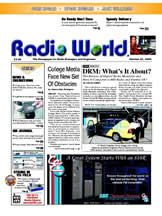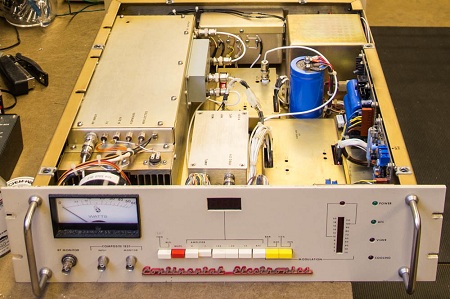 |
|
Fig. 1: The exciter,
with the original RF
amplifier section visible at
left rear.
|
We don�t
need to throw away equipment that is
capable of serving for many years to
come if it is updated on occasion.
The
Continental 802A FM exciter was
produced from 1983 to 1992. Many
remain in use but some have been
sidelined because of a failure in
the 50 watt RF amplifier section.
This
model was made with a Motorola
MRF315A transistor. Well, Motorola
is out of the semiconductor
business, and no company, to my
knowledge, is making a direct
substitute. Continental can replace
the RF amplifier module, including
heat sink and voltage regulator,
with a plug-in compatible module;
but this will cost around $2,000,
which is a lot of money considering
the exciter may not be worth that
much when operational.
An
802A crossed my service bench
recently with a problem. My answer
was to remove most of the RF power
amplifier circuit card and replace
it with a pallet amplifier from
Broadcast Concepts (www.broadcastconcepts.com).
Because the exciter's modulated
oscillator puts out only about 20 milliwatts, they provided me with a
modified version of a television
amplifier and called it an "80 Watt
FM Pallet, 40 dB gain, MTF173, 28
Volt (Custom)" amplifier at $249
plus shipping.
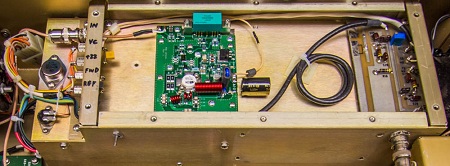 |
|
Fig. 2: The 802A
with the new pallet
amplifier.
|
This
dropped in nicely after most of the
original amplifier card was removed.
I left the directional coupler at
the output of this assembly so
forward and reflected power could be
monitored.
One
cautionary note. The pallet
amplifier, any amplifier, needs good
cooling. To do that, I carefully
marked mounting holes on the
original Continental heat sink. Then
I drilled and tapped holes so six
4-40 machine screws could tightly
secure the pallet's aluminum base to
the aluminum heat sink.
Silicon heat sink transfer compound
(Radio Shack 276-1372A) was used to
ensure good thermal contact between
the two. Both surfaces needed to be
absolutely flat before they were
joined. No accidental aluminum
drilling burrs were allowed.
Another case
The
Continental 802B FM Exciter is a
later, updated version of the A
offering. One arrived with serious
burn damage on its RF amplifier
circuit card, which could not be
repaired. Investigation revealed
that there were two or possibly
three versions of RF amplifiers used
in this model. Yes, another
candidate for a pallet amplifier.
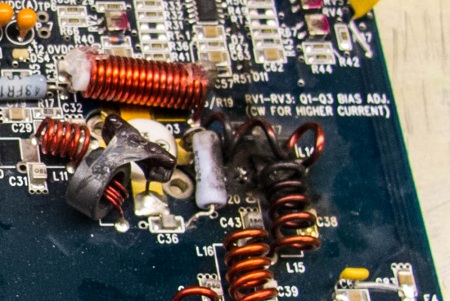 |
|
Fig. 3: Closeup of
burnt components in an 802B.
|
Doing
the change on an 802B was a bit more
complicated. In this model, an RF
low-pass filter was required for
restoration of the exciter to its
former glory. The A model had a
filter as an outboard option. That
didn�t apply here. So, I installed a
Broadcast Concepts 1500-watt
low-pass filter with directional
coupler on the same module. The cost
was only $125 plus shipping.
One
problem I had was that the filter
coils stood high enough above the
circuit card so they would short
when the top cover was put on the
module. The answer was some
1/4-inch-high aluminum bar stock
that raised the cover of the module
by that amount. It seems much of my
work while repairing and/or
restoring equipment is as a
machinist.
It
all worked out, although I had to
adjust component values on the
directional coupler and exciter
meter board to bring the forward and
reflected DC sample levels up high
enough to get proper metering.
A
known problem with these exciters is
seen in the case of the Darlington
voltage regulator transistor on the
RF power amplifier assembly. It will
fail, causing the exciter to go to a
full 50 watts or more of RF output.
A couple years ago, in the pages of
Radio World, I mentioned a
modification that adds a 4-ohm
resistor in series with the
regulator, to reduce its heat
dissipation.
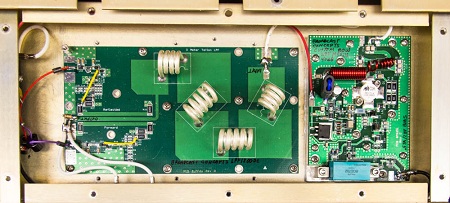 |
|
Fig. 4: The rehabbed
802B with the Broadcast
Concepts module at right.
|
I use
two 2-ohm/50 watt resistors in
series because 4-ohm resistors are
not a standard item. Sometimes I put
a switch in to short the resistors
when full power is required from the
exciter.
My
latest revision to that module also
replaces the original MJ3001
regulator transistor with an
MJ11023G. This newer transistor is
much more capable of handling
voltage and current. When installing
one, I remove the socket it belongs
to, because the new transistor has
larger diameter leads.
 |
|
Fig. 5: Aluminum bar
stock was added to clear
low-pass filter coils.
|
Yes, soldering is required here.
In one instance, the regulator
transistor broke into oscillation at
about 200 kHz, causing the exciter
to transmit on three frequencies
simultaneously. A 0.39 mfd poly
capacitor from base to emitter on
the transistor put a stop to that
problem.
Mark Persons, W0MH, holds CPBE
certification from the Society of
Broadcast Engineers and has more
than 30 years experience. His
website is
www.mwpersons.com. Find past
Tech Tips under the News &
Technology tab of
radioworld.com.
|


